“A provocation and a lens.” Future Ages Will Wonder – Reviewed
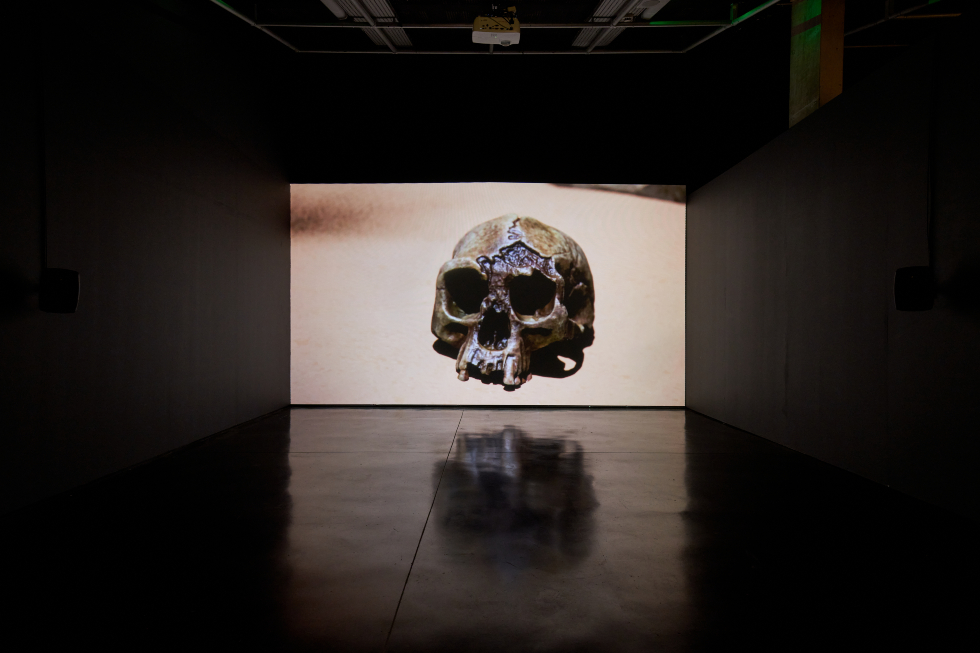
FACT’s exhibition Future Ages Will Wonder serves as both provocation and lens by which to address historical wrongs and to consider how we’ll be remembered by generations to come. Via the writings of Ursula K. Le Guin, Bethany Holmes gets to grips with this complex, nuanced show…
In The Carrier Bag Theory of Fiction, her brief, prescient essay written in 1986, Ursula K. Le Guin redefines technology as a cultural carrier bag rather than a weapon of domination. Before the invention of the spear, there was the humble container: ‘the basket of wild oats’. In prioritising the container, Le Guin proposes a method of storytelling and history distanced from the ‘Hero’ and violence, towards entanglements and liminality – collecting, holding and giving. An endeavour rooted in a communal existence, rather than an individualised one.
In the same way, Future Ages Will Wonder, the current exhibition at FACT in Liverpool, displays artworks that use science and technology to excavate a multiplicity of alternative histories. Set in motion by the powerful, the biased values and narratives of the past influence reality – at the expense of marginalised voices. But, as with Le Guin’s form of storytelling, art can configure and reconfigure worlds; it can point to fresh possibilities.
Zoe, Miku Aoki’s re-interpretation of The Hunterian Museum in Glasgow, absorbs FACT’s ground floor foyer and captures the show’s dreamlike quality. The centrepiece is a cabinet of curiosities, behind which hang purple-toned tapestries featuring handstitched museum specimens. Several stuffed mutants frame the installation, while a figure perching behind a refined wooden desk watches over the scene. One expects this figure is John Hunter, the 18th-century pioneer of artificial insemination whose anatomical and surgical collection forms part of The Hunterian.
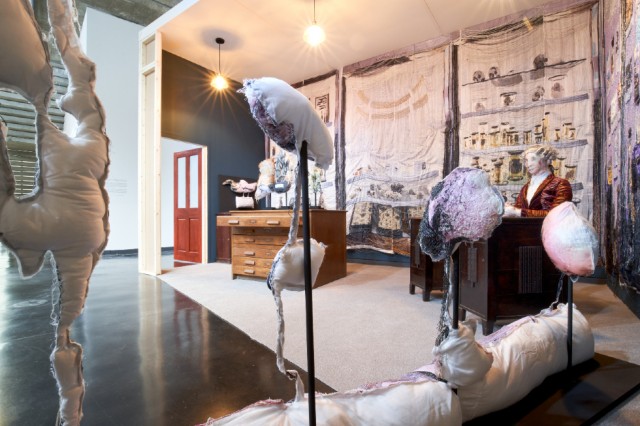
Aoki invites visitors to rework their preconceptions of science as objective, giving precedence to the historically overlooked domestic sphere, as well as latent intimacies. Born in 1996, the artist shares a birth year with Dolly the Sheep (the first cloned mammal) and conceived through IVF, the artist came to think of John Hunter as an abstract ‘father’.
Heading into the dimly lit space of Gallery 1, a polyphony of voices encompasses visitors, of which Yarli Allison’s is at the forefront. Their two-channel video, IN 1875 WE MET AT THE DOCKS OF LIVERPOOL 於梨花埠遇上 reconstructs Liverpool’s Chinatown – the oldest in Europe – and its lost Chinese sailors. A bold digital landscape intertwines oral history, interviews and census data with digital mapping and virtual reality.
The up-to-the-minute nature of this work contrasts with a sober shack made of metal and wood. Within this structure is a series of artefacts created by the Hong Kong/Canadian-born artist: watercolour drawings, a diorama, and a letter. These small works require a closer look, successfully drawing the viewer into a relationship with a fictional life.
Allison continues their empathetic exploration of diaspora histories in In Virtual Return You (can’t) Dehaunt / 於虛擬的彼岸 迴魂(不)散. The virtual reality docufiction follows four queer Hong Kong transmigrants and their memories of now non-existent childhood homes in colonial Hong Kong. These memories are virtually reconstructed and displayed on four screens; a changing, pastel-toned reel of objects and possessions interweaves with documentary footage. Such fluctuations are disorientating, perhaps mirroring the mindsets of those displaced by colonialism, traversing identity and memory, the recognisable and impersonal.
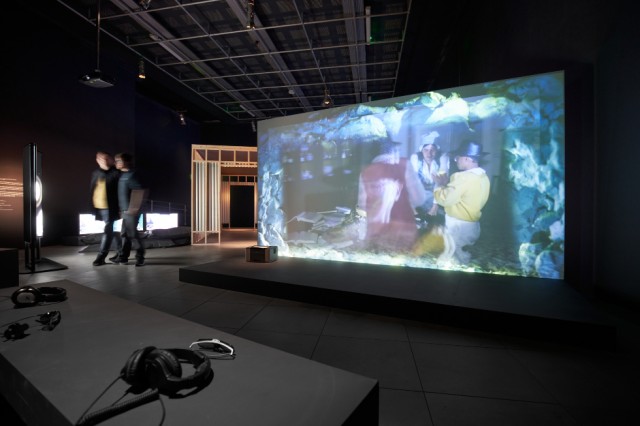
In the far-left corner of Gallery 1, Trisha Baga presents a speculative science-fiction film. Imagery from post-colonial societies connected to her Philippine heritage intersperses with stories of pre-colonial America extracted from so-called ‘narrative stem cells’ within Plymouth Rock – a symbol of European colonisation marking the supposed origins of the USA. Baga reframes these stories via an imaginary theatrical performance, led by a group of geneticists studying the deep-rooted ills of America who attempt to bioengineer and re-narrate the country’s crisis. The almost-translucent nature of this fractured, perplexing projection, and its towering size, add to its spectral atmosphere.
Continuing the theme of ancestral memories is Boedi Widjaja’s multi-site installation. Based on epigenetic findings (proposing that behaviour and environment can affect the way genes work) suggesting we inherit ancestral memories, Widjaja asks whether it could be possible to inherit images and sounds through DNA transmissions.
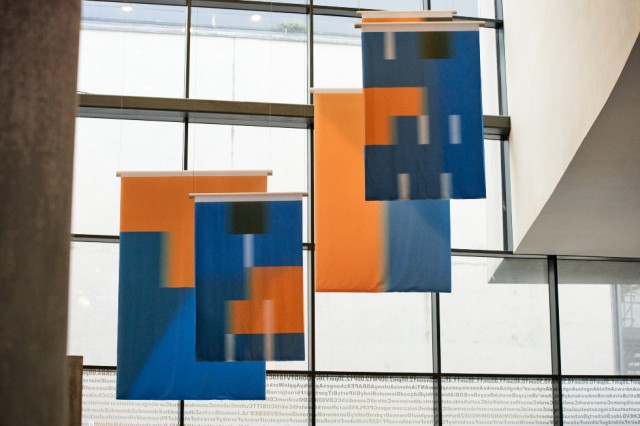
A lightbox displays photographs taken during his first visit to his familial hometown in Indonesia, and an ethereal generative work animates inverted images. Underscoring the animation is an ambient soundtrack composed of hybrid DNA: Widjaja’s genetic code, the Chinese parasol tree, and an encoded text. Widjaja’s work continues in the foyer, a group of flags reclaim physical space for his voice, and on the stairs, three backlit prints combine his genetic code as an embodied form of poetry. Positioned here, these works feel somewhat unmoored from the rest of the show, requiring close attention from the viewer to unpack them.
In Gallery 2, South Korean artist duo Breakwater (Youngsook Choi and Taey Iohe) present Fermented Flower, a large format cotton print and accompanying audio of symbolic bells. Their work unpicks multiple histories by referencing traditional Asian religious murals – from the racist roots of botany (which saw Victorian era expeditions commissioned to ‘discover’ and lay claim to ‘new’ plant species) to systemic violence relating to land and labour.
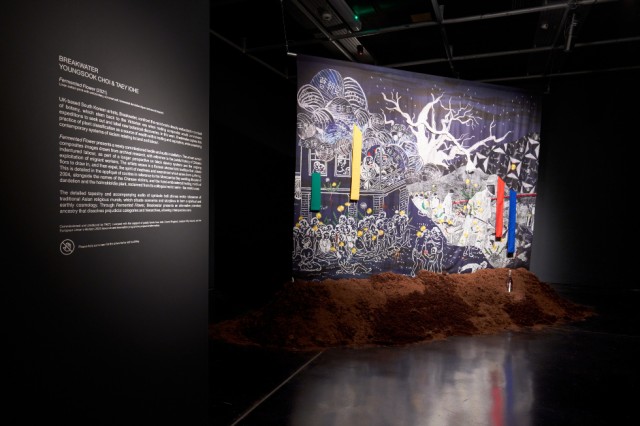
Detailed applique alludes to the Morecambe Bay cockling disaster of 2004, and hand-embroidered dandelions and holmskioldia plants reference a Korean shamanistic tradition that expels suffering. The print comprises predominantly black and white stitching, making the sharp reds of blood-drinking capitalists seem more prominent, particularly in contrast to the healing yellows of flora and fauna.
As with botany, science has justified prejudice. In Dust to Data, a new film by Larry Achiampong and David Blandy, the UK-based artists track the colonial history of archaeology, interrogating the construction of ‘civilisation’ and racist ‘origin’ stories to parallels in the present, namely data mining of DNA and social media image banks. The duo references the assumed logic of science via a gleaming, ordered pyramid and 3D models of Australopithecine skulls. These disembodied motifs nod towards outdated notions that still permeate assumptions.
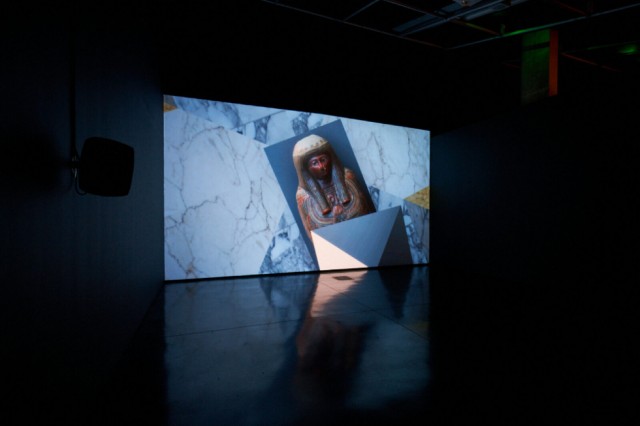
The final work of the exhibition is by Ai Hasagawa. Using computer-generated imagery, photography, and design, she considers the ‘traditional’ family unit and future genetic possibilities. (Im)possible Baby, Case 01: Asako & Moriga investigates emerging biotechnologies that could enable same-sex couples to have genetically related children, analysing the DNA data of a lesbian couple to visualise their potential children through fictional family photos. Shared Baby, meanwhile, imagines a future where multiple genetic parents could generate children. Together, the works provoke implicit questions (and propose plausible possibilities) relating to the future make-up of family units.
The writings of Le Guin have influenced the social theorist Donna Haraway deeply. Haraway implores us to tell other stories about our ‘weird, shared reality’. Art and technology are mediums through which we can explore this concept: imagining and reimagining the past, present and future to question who we are, what we are part of and how we might affect positive change. Although at times challenging, bewildering and over-crowded, Future Ages Will Wonder is a perceptive and ambitious exhibition. The viewer is required to sit with it, to be curious rather than credulous, to interrogate and speculate, particularly in relation to the present and the legacies we might leave for future generations. Future Ages Will Wonder is an invitation for visitors themselves to ‘wonder’ – a praxis centring on the power of the imagination.
Bethany Holmes
Images, from top: Larry Achiampong and David Blandy, Dust to Data (2021); Miku Aoki, Zoe (2019-2020); Trisha Baga, 1620 (2020); Boedi Widjaja, A Tree+++ (2021); Breakwater, Fermented Flowers (2021); Larry Achiampong and David Blandy, Dust to Data (2021). All images by Rob Battersby, installation views at FACT
Future Ages Will Wonder continues at FACT Liverpool until 20 February





